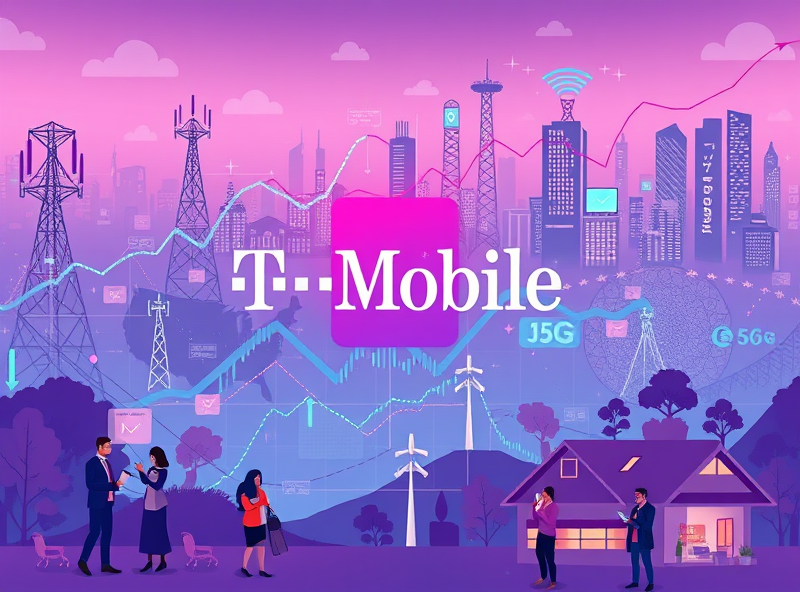
T-Mobile Stock Analysis 2025: 5G Leader or Overhyped?
Strong Financials and Subscriber Growth

T-Mobile has consistently demonstrated strong financial performance, and as we look toward 2025, its momentum shows no signs of slowing. The company’s solid earnings, expanding subscriber base, and aggressive 5G rollout strategy position it as a serious contender in the telecom space.
In recent quarters, T-Mobile has reported robust revenue growth, driven largely by its postpaid phone net additions — a key metric in the wireless industry. In fact, T-Mobile led the U.S. wireless market in postpaid phone net additions for several consecutive quarters, outpacing both Verizon and AT&T. This growth reflects not only effective marketing and competitive pricing but also customer satisfaction and retention.
Financially, T-Mobile’s EBITDA (earnings before interest, taxes, depreciation, and amortization) has grown steadily, indicating operational efficiency and profitability. Its free cash flow is also on the rise, giving the company more flexibility to invest in network expansion and shareholder returns. With a strong balance sheet and reduced merger-related costs following the Sprint integration, T-Mobile is in a healthier financial position than many of its competitors.
The company’s aggressive investment in 5G infrastructure has also started to pay off. As of 2024, T-Mobile boasts the largest and fastest 5G network in the U.S., according to third-party analyses like those from Opensignal (https://www.opensignal.com/reports/2024/01/usa/mobile-network-experience). This network advantage is a key driver behind its subscriber growth and will likely continue to attract new customers through 2025.
For investors and consumers alike, T-Mobile’s strong financials and subscriber momentum suggest a stable and potentially rewarding outlook. Whether you’re considering investing or simply choosing a reliable mobile provider, T-Mobile’s current trajectory is worth paying attention to.
T-Mobile’s 5G Superiority and Expansion Strategy

T-Mobile has firmly positioned itself as a frontrunner in the 5G race, and its strategic expansion efforts are key to its long-term growth. As of 2024, T-Mobile boasts the largest 5G network coverage in the United States, reaching over 330 million people with its Extended Range 5G and more than 300 million with Ultra Capacity 5G. This expansive reach is not just about quantity—it’s about quality. T-Mobile’s mid-band spectrum (2.5 GHz) offers a sweet spot between speed and coverage, giving it a competitive edge over rivals like Verizon and AT&T.
The company’s 5G strategy hinges on three pillars: aggressive spectrum acquisition, rapid infrastructure deployment, and innovative partnerships. Since its merger with Sprint in 2020, T-Mobile has leveraged Sprint’s mid-band spectrum to accelerate its 5G rollout. This has allowed them to deliver faster speeds and lower latency to more users across urban and rural areas alike.
Moreover, T-Mobile is investing heavily in network densification—adding more small cells and upgrading existing towers—to improve capacity and performance. This is particularly important as data consumption continues to rise with applications like streaming, gaming, and IoT devices.
T-Mobile’s leadership in 5G is also attracting enterprise clients. Its 5G Advanced Network Solutions (ANS) are being adopted by businesses looking to modernize operations with private networks and edge computing. These moves not only diversify revenue streams but also solidify T-Mobile’s position as a tech-forward telecom provider.
For investors, T-Mobile’s strategic 5G expansion offers a compelling growth narrative. The company’s focus on scalable infrastructure and customer-centric innovation suggests it’s not just riding the 5G wave—it’s helping shape it.
For more details on T-Mobile’s 5G coverage and strategy, you can visit their official newsroom: https://www.t-mobile.com/news/network/5g-coverage-update
Valuation Insights: Price vs Fundamental Value

When evaluating T-Mobile’s stock in 2025, it’s essential to look beyond the share price and examine its intrinsic value. T-Mobile (NASDAQ: TMUS) has been a standout in the telecom sector, especially with its aggressive 5G rollout. However, investors should ask: is the current market price justified by the company’s fundamentals?
As of early 2025, T-Mobile’s stock is trading at a price-to-earnings (P/E) ratio slightly above the industry average. This suggests that investors are pricing in future growth, particularly from its 5G infrastructure and subscriber expansion. But while revenue and EBITDA have shown consistent growth, free cash flow margins remain under pressure due to ongoing capital expenditures in network development.
A discounted cash flow (DCF) analysis indicates that T-Mobile’s fair value may be slightly below its current market price, implying the stock could be modestly overvalued. However, if the company maintains its momentum in subscriber growth and cost efficiencies post-merger with Sprint, the valuation premium may be justified.
Investors should also consider T-Mobile’s relatively low debt-to-equity ratio compared to competitors like AT&T and Verizon, which strengthens its financial position. In short, while T-Mobile’s stock may appear pricey on the surface, its long-term fundamentals and market position in 5G could support its valuation — if execution remains strong.
For a deeper dive into T-Mobile’s financials, you can visit their official investor relations page: https://investor.t-mobile.com/
Risks and Long-Term Opportunities for Investors

As we look ahead to 2025, T-Mobile remains a key player in the U.S. telecom industry, particularly due to its aggressive 5G rollout and subscriber growth. However, investors should be aware of both the risks and the long-term opportunities that come with investing in T-Mobile stock.
Let’s start with the risks. One of the primary concerns is the increasing competition in the 5G space. While T-Mobile currently holds a lead in mid-band 5G coverage, competitors like Verizon and AT&T are rapidly catching up. This could lead to pricing pressure and reduced margins in the future. Additionally, T-Mobile’s high capital expenditures for network expansion may strain free cash flow in the short term. Regulatory risks also remain, especially with potential changes in spectrum policy or antitrust scrutiny.
On the opportunity side, T-Mobile is well-positioned to benefit from the growing demand for high-speed mobile data. The company’s integration of Sprint has resulted in cost synergies and a stronger spectrum portfolio, which supports its 5G leadership. Furthermore, T-Mobile’s expansion into fixed wireless access (FWA) for home internet opens up a new revenue stream, potentially disrupting traditional broadband providers.
For long-term investors, T-Mobile offers a compelling growth story backed by solid fundamentals. The company has consistently increased its subscriber base and improved its EBITDA margins. If it continues to execute its 5G strategy effectively, T-Mobile could see significant upside by 2025 and beyond.
For a deeper look at T-Mobile’s financials and strategy, you can refer to their official investor relations page: https://investor.t-mobile.com/







